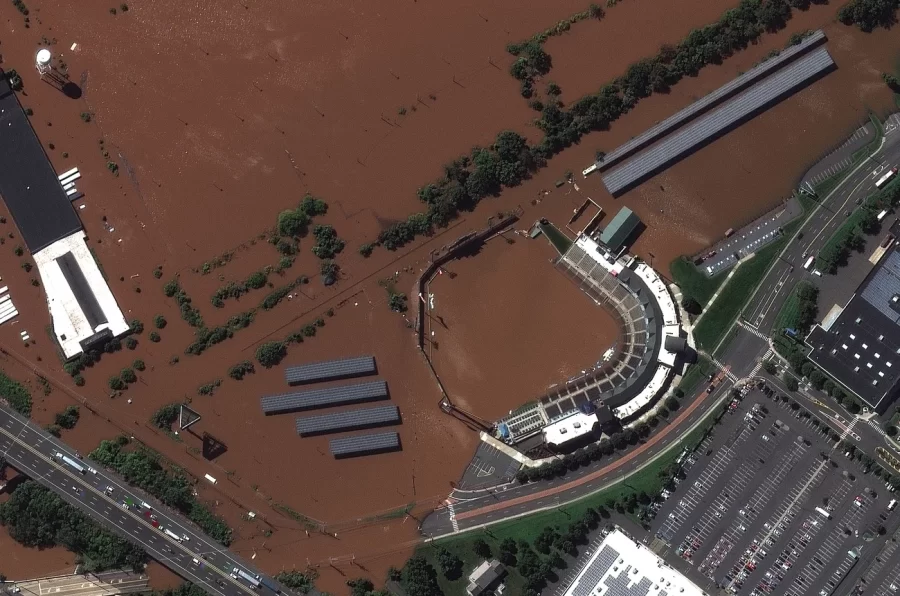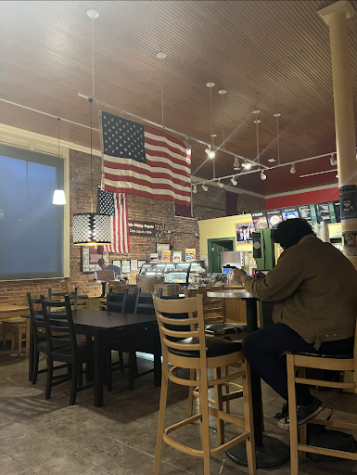Swept Away: How Local Businesses Are Handling the Recent Northeast Flooding
Courtesy of Maxar Technologies
TD Bank Ballpark, where the Somerset Patriots play, partially submerged
On September 1st of this year, New Jersey and several surrounding states were hit by the remnants of Hurricane Ida. Hunterdon county was among the areas in NJ that experienced severe flooding. It was a Category 4 hurricane, and it started in Louisiana on August 29th, only two days prior. The storm was one of the worst that the East Coast has seen in years. Several tornadoes touched down in Hunterdon County alone. Many people were trapped by the terrible storm and the following flood. Numerous roads were closed, so people couldn’t leave or return to their homes. An employee from Flemington’s Shoprite described their experience working during the storm: “I was working at Shoprite [from] 4:45-9:30, and [management] weren’t letting us leave for a while because of the weather. There was no possible way for my parents to drive [to pick them up from work] because the intersection was completely closed. There were abandoned cars everywhere so they walked to come to get me. My coworkers, who were still there when I left, are probably staying the night.” While the workers at Shoprite were able to leave at 2 am the following morning, September the 2nd, the damage left from the flood was felt long after.
The students of Hunterdon Central Regional High School felt the impacts from the storm when the school experienced flooding, causing the first day of school to be pushed back. Currently, the floors of the 600s hallways in the 11/12 building show clear signs of water damage, and whole classrooms are currently unusable for the time being. If the school was damaged that bad, to the point where they were forced to close for a day, how bad did it affect local businesses?
Referring back to ShopRite, according to the same source from earlier in the article, “around 3 or 4 aisles had leakage from beneath the shelving….I can’t say for certain how much damage there was…”
Due to the flooding, many businesses lost up to thousands of dollars in goods damaged by the floodwater. Both Fisherman Mark’s in Lambertville, which provides social services alongside being a food pantry, and Delaware Valley’s Food Pantry experienced flooding. Delaware Valley’s Food Pantry experienced such severe flooding that, for the time being, they have had to move locations for a brief time to the Centenary United Methodist Church.
Many larger retail and grocery stores did not close during the storm, and due to the severity of the flooding, night shift workers weren’t able to get to work. According to another
source, some of the roads were so severely flooded that emergency responders were not able to reach the scenes of some emergencies. Homeowners had to remove floodwater on their own, since the roads were still too dangerous for flood responders to risk travel. This was usually done using buckets, baskets, cups, and anything else that could hold water.
With the recent rise in high-intensity storms, often attributed to climate change, it seems like an opportune time for businesses to look into better ways to prevent and handle flooding, in addition to maintaining the safety of the people. Precautions such as flood insurance, normally needed only in coastal and tropical areas, might become commonplace as climate experts warn of future storms reaching the East Coast. At least six lives were lost to the storm in Hunterdon County alone, so employee safety is as important, if not more important, than just the preparation. Better pump systems, an updated building infrastructure, and better measures for employee safety are must haves before the next storm. Although the storm came as a shock to many on the East Coast, experts warn that this is just the beginning.
















